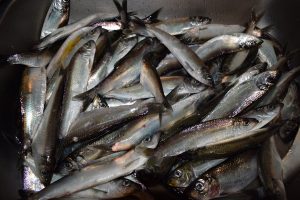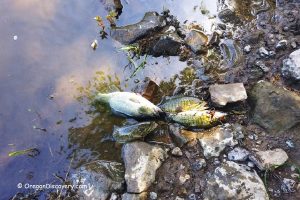
Oregon has a wealth of fishing streams, making Steelhead Trout Fishing in Oregon very popular. The state has a variety of fish, but most anglers spend time chasing the steelhead trout more than any other fish such as native rainbow, cutthroat and bull trout. Steelhead has been called the definitive game fish. These are elusive and challenging. They would test your patience and persistence over and over again. However, catching a steelhead, a fish renowned for its resilience and a remarkable acrobatic fight is the ultimate reward.
Steelhead Trout Life Cycle
Steelhead is oceangoing rainbow trout that adopted the anadromous lifestyle similar to salmon. They are conceived in freshwater streams and spend their first 1-3 years of life in there. They then go to the ocean where most of their development takes place. After one to four growing seasons in the ocean, steelhead comes back to their native freshwater stream to spawn. This fish does not die after reproducing and can brood several times, unlike other salmon species.
The duration for eggs to hatch is heavily dependent on the temperature of the water. In hatcheries where the environment is carefully controlled, steelhead eggs hatch after 30 days at a temperature of 51°F. In warmer water eggs hatch faster, but the young fish are smaller and have higher mortality rates.
The developing steelhead, known as alevins will live in the gravel for another four to six weeks. They receive nutrients from a yolk sack stuck on their body. When they surface from the gravel, they are called fry and can catch their food.
The Oregon angler would fish for steelhead all year round. It does not matter if the waters are freezing cold in the north coast streams or in January or if the waters are bubbling hot in the central desert rivers.
Video
License
Other than securing a license to fish, anglers have to buy a Combined Angling Tag for sturgeon, salmon, steelhead, and Pacific halibut. Also a Hatchery Harvest card is available. Harvested wild adult salmon or steelhead must be recorded on the Combined Angling Tag. Hatchery salmon or steelhead can be recorded on the Combined Angling Tag or a Hatchery Harvest Tag. Anglers can purchase only one Combined Angling Tag per year and as many as needed Hatchery Harvest Tags.
Time and Location of Angling
The two chief runs of Steelhead Trout in Oregon are the "Summer,” and "Winter" runs. The time of the year when the fish get into the freshwater determines the steelhead run.
Certain streams accommodate both runs but most get either one of them. The fish enter the water at different intervals of reproductive maturity. Therefore, you will find all sizes of steelheads. Focus on the bigger ones and save the smaller ones for the next run.
To get a better sense of when the runs start, get yourself acquainted with fishing recreational guides and outlines. They detail the fishing conditions especially for steelhead Trouts in Oregon river systems.
Fishing Techniques
There are several techniques for steelhead fishing that anglers can apply. There secrets catching steelhead irrespective of the gear you choose to use have to do with your patience and optimism.
Take as much time as necessary on the water. Learn the river and polish your methods. You are likely to hook more fish this way than if you decide to run after every lead you think is hot. Cover the water adequately, have your bait or lure close to the bottom and systematically fish every section of the stream. Keep your hope high because it takes time. Be confident in your equipment; the bait you are using and trust that the waters would deliver.
Some techniques include:
- Drift fishing
- Plunking
- Spinners
- Pulling plugs
- Fly Fishing
As you take part in Steelhead Trout fishing in Oregon, there are going to be other anglers with whom you will definitely share space and a run. There is etiquette that assists in creating an enjoyable experience for all the participants. Some key elements of this include:
1. Allow bank anglers enough room if you are boat fishing. Do not block anyone fishing from the bank.
2. Leave adequate space between yourself and your fishing neighbor who could be on the bank or in a boat in the water. It could be frustrating to repeatedly knock elbows with someone as you try to fish in peace.
A new angler may run upstream whereas veteran steelhead anglers slowly move downstream to cover the whole run. If you're unsure of the direction to take, ask an angler next to you. Most of them are glad to guide you through a run. With these guidelines, you are sure to catch fish on your next trip.
Nutrition Facts
Steelhead trout is a healthy choice for your diet. While containing a low level of mercury, pesticides, dioxin and other contaminants, this fish is rich in omega-3 fatty acids, vitamins, minerals and lean protein. It has pink flesh and can be baked, grilled, fried, and steamed.
You May Also Like








